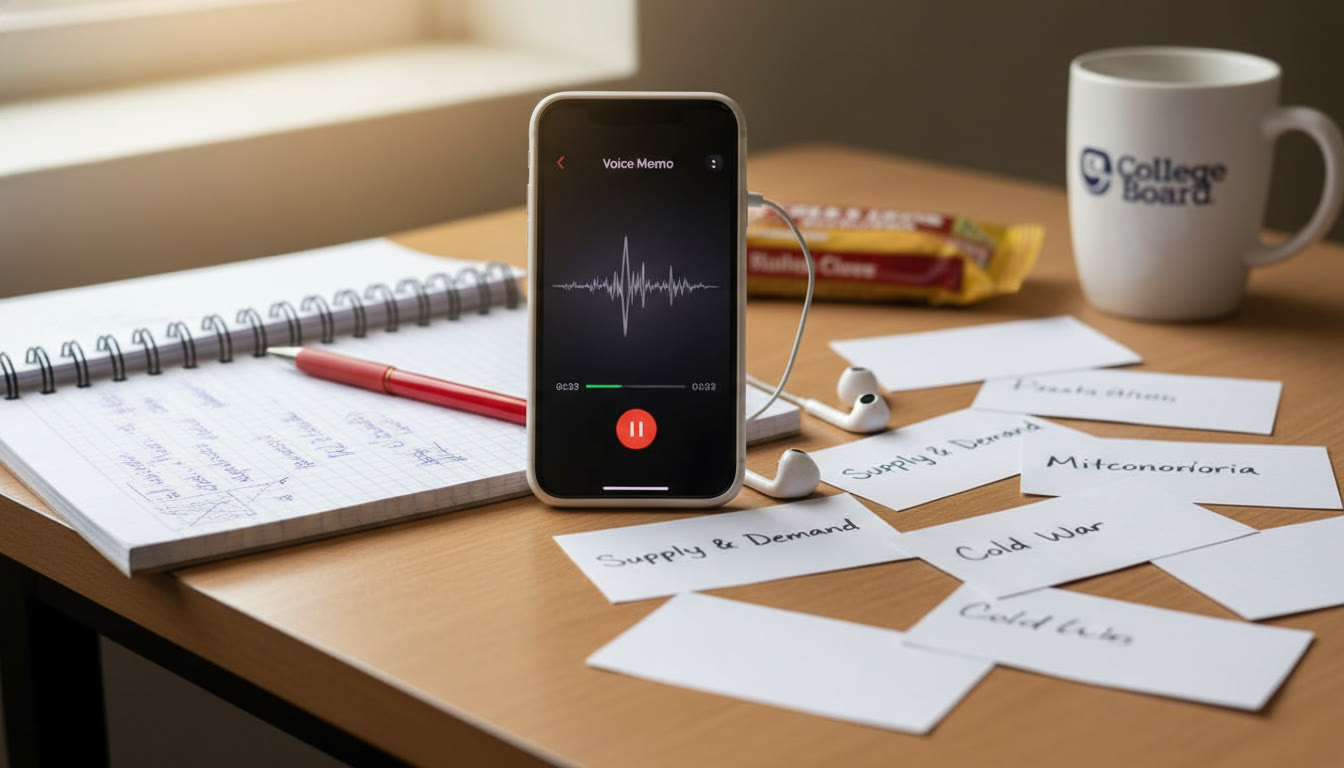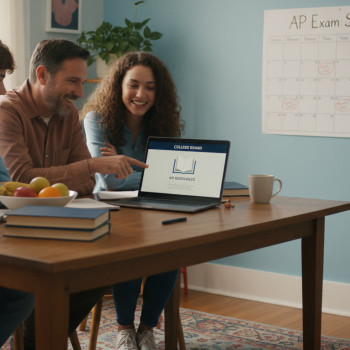Why Your Commute Can Be Your Secret Study Weapon
Think about the minutes you spend waiting for a bus, walking to class, or riding the train. Those pockets of time add up—often to hours each week. Instead of doomscrolling, you can transform that time into purposeful, low-stress AP review that actually moves your score needle. This commute learning plan uses three simple, science-friendly pillars: audio, notes, and flashcards. Together they create a loop of input, organization, and retrieval practice that fits neatly into a backpack and a pair of earbuds.
Before we dive into the how-to, two quick truths to anchor us: first, frequent short bursts of practice beat rare long cram sessions; second, active recall (testing yourself) and spaced repetition (revisiting material over increasing intervals) are the heavy hitters for long-term retention. This plan stitches those principles into everyday travel—without turning your commute into one more stressful obligation.
Practical note: if you use official AP resources like AP Daily videos or AP Classroom assignments as part of your commute prep, they slot perfectly into the audio pillar and help you stay aligned to course expectations. ([apcentral.collegeboard.org]( Pillars of the Commute Learning Plan
1) Audio: Learn by Listening
Audio turns passive travel into meaningful review. Podcasts, recorded lessons, and brief guided recaps let you absorb concepts while keeping your eyes on the road (if you’re the driver, don’t study anything visual—use spoken summaries only). Audio is especially powerful for courses heavy on narrative, concepts, or verbal reasoning: AP US History, AP Biology (conceptual overviews), AP English Language (rhetorical strategies), and AP Psychology all benefit from repeated, spoken summaries.
How to use audio well:
- Choose short segments (5–12 minutes). They’re easier to replay and digest during a single commute stretch.
- Record your own mini-lectures. Speaking aloud forces you to organize ideas—then listen back to spot gaps.
- Use AP Daily videos and topic summaries as a foundation for audio sessions; summarize each video in 2–3 minutes and store it as a voice memo for commute listening. ([apcentral.collegeboard.org](
- Vary listening speed. 1.25× can save time without hurting comprehension; slow down to 0.9× for dense passages.

2) Notes: Capture, Condense, Clarify
Good notes turn noisy recall into a tidy roadmap. The commute plan treats notes as the bridge between audio input and flashcard output. Rather than rewriting entire textbook pages, use a three-part structure: One-line Summary, Key Terms & Dates, and One Example/Question. This keeps notes portable and flashcard-ready.
Note-taking workflow:
- During or immediately after an audio session, jot a one-line thesis for the topic (e.g., “Manifest Destiny accelerated sectional tensions by expanding slavery debate”).
- List 3–6 key terms, formulas, or dates under that thesis.
- Write one active prompt or question you can turn into a flashcard (e.g., “Explain how the Missouri Compromise affected sectional politics”).
This structure makes later review efficient and helps prevent bloated, unusable notes. If you have access to a tutor or a 1-on-1 session—Sparkl’s personalized tutoring model, with tailored study plans, can help you refine this note structure and turn weak summaries into examiner-ready arguments—consider bringing a sample page to get feedback.
3) Flashcards: Turn Notes into Retrieval Practice
Flashcards are the active-recall engine. Convert each note’s “active prompt” into a card. For conceptual questions, use a prompt-answer format; for definitions, use term–definition; for problem-solving (AP Calculus, AP Chemistry), include a worked-solution card that walks through steps on the reverse.
Flashcard tips that amplify commute value:
- Keep cards bite-sized. One idea per card.
- Use spaced repetition software (SRS) or a physical box with labeled intervals—this schedules review automatically so commute minutes become strategically spaced practice.
- Include images or quick diagrams on cards for visual subjects; write minimal text to force active recall.
Example card types for AP subjects:
- AP Biology: “Describe the sodium-potassium pump mechanism and its role in membrane potential.”
- AP US History: “List three causes of the Panic of 1837 and explain one consequence.”
- AP English: “Define ‘anaphora’ and provide an example from a speech you know.”
- AP Calculus: “Solve integral of sin(2x) dx—show substitution steps on back.”
Sample Weekly Commute Study Schedule
This sample assumes a five-day school week with a round-trip commute of about 40–60 minutes per day. Adapt durations to your real commute and course load. Prioritize subjects with upcoming assessments.
| Day | Morning Commute (20–30 min) | Afternoon Commute (20–30 min) | Extra Short Burst (5–10 min) |
|---|---|---|---|
| Monday | Listen: 10-min AP Daily recap + 10-min self-summary recording | Flashcards (SRS review: 15 cards) | Write one-line summary for a chapter |
| Tuesday | Review voice memo; add 2 notes to notebook | Flashcards: timed retrieval (answer without hints) | Create 3 new flashcards from notes |
| Wednesday | Listen to a practice problem walkthrough (audio) | Active recall: explain solution aloud | Polish one-card explanation |
| Thursday | Focused listening: 8-minute thematic overview + 10-min notes | Flashcards: SRS review + flag two weak cards | Record a 2-minute summary for weak cards |
| Friday | Mock oral exam: answer 3 potential free-response prompts aloud | Review flagged cards and record corrections | Plan weekend longer session (45–60 min) |
This schedule balances new input, consolidation, and low-stakes testing. Short weekend sessions should expand on the week’s weak points and include a timed practice question to simulate exam pressure.
How to Build Your Audio Library
You don’t need a professional microphone to create effective audio—your phone will do. The goal is clarity and structure. Each audio clip should follow a simple template: Title, Two–Three Key Points, One Example, One Practice Question. Keep clips between 3 and 12 minutes so they fit commute windows.
Audio sources to consider:
- AP Daily videos and short topic overviews for course alignment. ([apcentral.collegeboard.org](
- Lectures you record yourself after reviewing notes—this reinforces understanding.
- Teacher-recorded summaries or class recap audio (if your teacher shares them).
Pro tip: after recording, listen once at normal speed and once at 1.25× to decide which speed you’ll use during commutes—some dense material needs slower playback, and some review material benefits from quicker repetition.
Designing Notes That Turn Into Great Flashcards
Your notes should be a low-friction translation into flashcards. Use a two-column layout in a small spiral notebook or digital note app: left column = compact prompts/questions; right column = short answers (2–4 lines). Add a tiny number in the corner of each note to link it to a flashcard set or SRS tag so you can track how often you review that concept.
Structure example for a single topic (AP Chemistry — Gas Laws):
- One-line summary: “Gas laws relate pressure, volume, temperature, and amount—use PV=nRT for combined problems.”
- Key terms: Boyle’s Law, Charles’s Law, Avogadro’s Law, Ideal Gas Law
- One practice prompt: “Given initial P1,V1,T1 and final V2,T2, find P2.”
Flashcard Formats: What Works Best for AP Exams
Different AP subjects favor different card styles. Mix formats to mirror exam demands.
- Definition Cards — for vocabulary and laws (AP Biology, AP Chemistry, AP Psychology).
- Concept Explanation Cards — prompt with “Explain why…” or “Describe how…” for FRQ-style thinking (AP History, AP Environmental Science).
- Worked Example Cards — show the problem on the front and the full solution steps on the back (AP Calculus, AP Physics).
- Image or Diagram Cards — sketch a quick figure on the front and label/explain on the back (AP Human Geography, AP Biology).
Measuring Progress: Small Metrics That Matter
Skip vague notions like “studied a lot” and track meaningful metrics that fit the commute model. Every week, log:
- Minutes of focused audio listened
- Number of new flashcards created
- Percent correct on SRS review that week
- One timed FRQ or practice problem completed
Use a tiny habit tracker or a Google Sheet to see trends. If SRS accuracy drops for a topic, schedule two extra commute review sessions focused solely on that material the next week. Tutors—like the personalized 1-on-1 sessions Sparkl offers—can help interpret these metrics and adjust your study plan so you don’t waste time on strategies that aren’t moving the needle.
Study Examples: How This Plan Looks for Different AP Subjects
AP Biology (Conceptual + Terms)
Audio: 8–10 minute explanation of cellular respiration pathway.
Notes: One-line summary + 5 key terms (glycolysis, Krebs, ETC, ATP yield, oxidative phosphorylation).
Flashcards: Term cards, and 3 worked-example cards where you explain the energy yield from glucose under aerobic vs. anaerobic conditions.
AP US History (Narrative + Dates)
Audio: 10-minute thematic overview (e.g., Causes of the Civil War).
Notes: One-line thesis, 6 dates/events, one FRQ-style prompt.
Flashcards: Cause–effect cards and a handful of document-analysis prompts for oral practice on the commute.
AP Calculus (Procedural)
Audio: Short walkthroughs of problem types (e.g., “three ways to integrate by parts”).
Notes: Compact steps for each technique.
Flashcards: Front shows integral, back shows concise step-by-step solution; use SRS to keep old methods fresh.
Safety, Concentration, and Etiquette
Never study from visually dense material while cycling or driving. If you’re a passenger, visual review is fine; if you’re behind the wheel, stick to audio and voice-based active recall. Be mindful of volume in public spaces and respect your fellow commuters. Use noise-cancelling buds if background noise ruins comprehension, but remember to keep one earbud out if you need to stay aware of your surroundings for safety.
Tools and Tech That Make the Plan Low-Friction
Here are tools that many students find helpful (use whichever matches your workflow):
- Voice memo/recorder on your phone for personal summaries.
- A compact notebook or a small digital note app (choose one for quick capture).
- SRS flashcard apps for automatic spacing and analytics.
- Noise-cancelling or open-ear earbuds depending on environment and safety needs.
If you want more structured support, a short series of 1-on-1 tutoring sessions—such as those provided through Sparkl—can help you build high-quality audio scripts, tighten your notes, and design flashcards that target exam-writing skills. Tutors can also simulate oral exams so your commute practice becomes high-value retrieval under realistic pressure.
Common Roadblocks and How to Fix Them
“I don’t have time to record audio or make flashcards.”
Start with 1 minute a day: record a single 60–90 second summary and create one flashcard. Consistency beats volume. Over two weeks, those tiny bits compound into dozens of cards and multiple recordings.
“I zone out while listening.”
Switch to active listening: pause after each key point and summarize aloud for 15–30 seconds. You’ll anchor attention and produce a voice memo you can re-listen to later.
“My flashcards are messy or too long.”
If a card takes more than 20 seconds to answer, split it into two. Break complex prompts into stepwise cards that guide you through the chain of reasoning rather than burying everything on one card.
Exam-Week Commute Strategy
Two weeks before your exam, lean heavier into SRS and targeted weak-point review. Keep morning commutes for light audio warm-ups and confidence-building recap (one minute of key formulas or high-impact dates). Use afternoon commutes for active retrieval and flagged-card remediation. In the final 48 hours, favor short concept checks and one timed practice section—save heavy learning for earlier weeks.
Also, confirm exam logistics—registration, test format, and key dates—well in advance so your study plan is tuned to the correct format (digital or paper) and schedule. Official College Board resources explain how to access AP Classroom and AP Daily videos, which can be helpful if your study needs to mirror exam changes. ([apstudents.collegeboard.org]( Two Commutes That Added Up to an AP Score Jump
Case study (composite): Maya was juggling AP Biology and AP US History with a 45-minute round-trip commute. She recorded 5–7 minute recaps after class, converted them to 20 flashcards per week, and used SRS for daily 10–15 minute commute reviews. Over eight weeks she reported stronger recall on FRQs and moved key topics from “I know vaguely” to “I can explain and apply.” Her micro-practice transformed vague familiarity into structured knowledge ready for exam use.
Putting It All Together: A One-Week Quick-Start Plan
Follow this checklist for your first week:
- Day 1: Identify your top two AP subjects. Record one 3–5 minute summary for each. Create five flashcards total.
- Day 2: Listen to each summary in the commute. Add two notes per subject. Create three new cards.
- Day 3: Use SRS review on flagged cards. Record one corrected summary for any weak spot.
- Day 4: Do a timed 15-minute practice question for one subject during the afternoon commute (speak your answer aloud).
- Day 5: Tally metrics (minutes audio, cards made, SRS accuracy), and plan weekend deep dive.

Final Notes and Motivation
Transforming commute time from wasted minutes into meaningful study is less about magic and more about rhythm. The audio–notes–flashcards loop creates a compact, repeatable system you can rely on even during busy seasons. Keep the materials simple, measure the little things, and iterate. If you feel stuck, a few targeted tutoring sessions (for example, Sparkl’s 1-on-1 guidance and AI-driven insight features) can quickly sharpen your plan and help you prioritize the few concepts that make the biggest difference on exam day.
Remember: preparation is cumulative. The micro-choices you make on a Tuesday morning add up to clarity and confidence in May. Treat your commute as study time that respects your life—short, focused, and kind to your mental energy—and you’ll be surprised how much progress you can make without rearranging your whole schedule.
Quick Checklist to Start Today
- Pick one audio topic and record a 3–5 minute summary.
- Create five flashcards from your most recent notes.
- Commit to 10–15 minutes of SRS flashcard review each commute.
- Log minutes and card counts at the end of the week and adjust.
Now put on your earbuds and give it one commute. Small, steady motion wins the race.























No Comments
Leave a comment Cancel